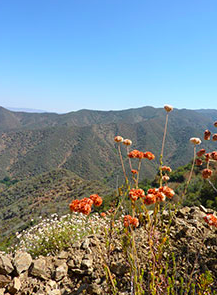Overall Vegetation of Magic Mountain Wilderness
The overall vegetation for Magic Mountain wilderness is typical of any wilderness that you would expect to find in Southern California. At first glance at pictures, the valley appears to be covered in low to the ground shrubs, with an occasional what looks like common weed flowers. Upon further investigation, those low lying shrubs that cover the valley of Magic Mountain wilderness, are called Chaparral (Bureau of Land Management, Fish and Wildlife Service, Forest Service and National Park Service 2015). Considering how many forest fires the state of California has each year, the shrub of Chaparral has several qualities that allow even after severe forest fires for regrowth. Chaparral is a small woody shrub, that has the capability to survive without rain for a long period of time (Horton, J. S., & Kraebel, C. J. 1955).
The Magic Mountain wilderness climate zone is considered to be a desert. Deserts typically have a standard array of these plants; cacti, trees, shrubs, and succulents. As mentioned before in the paper, a common shrub that covers the valley of Magic Mountain wilderness, is the Chaparral. (Bureau of Land Management, Fish and Wildlife Service, Forest Service and National Park Service 2015). Most plants in the desert will have succulent like qualities, these plants will have thick leaves and stems for water storage, to prevent the plants from drying out in the dry environments (Funk & Wagnalls New World Encyclopedia 2015). The shrubs and trees in these areas often depend on rain in the seasons that have cooler temperatures. Overall I enjoyed learning about the vegetation for Magic Mountain wilderness, I would hope to eventually go there and visit the scenic beauty.
Zoe Vonclausburg

- Image was obtained through the wilderness website listed below
Works Cited
Bureau of Land Management, Fish and Wildlife Service, Forest Service and National Park
Service. 9/21/2015 (last updated). Wilderness.net
http://www.wilderness.net/NWPS/wildView?WID=732 Accessed on 3/11/2016
Horton, J. S., & Kraebel, C. J.. (1955). Development of Vegetation after Fire in the Chamise
Chaparral of Southern California. Ecology, 36(2), 244–262.
Funk & Wagnalls New World Encyclopedia (2015). Succulent., 1p. 1. Web. Accessed on 3/14/2016.
This seems like a really cool place. I wish you talked in more detail about some of the qualities that allow the Chaparral to continue to thrive in this region, and I agree I would definitely want to go check it out one day.
LikeLike
Very cool, I had no idea that that climate zone is considered the desert. Would love to learn more about the Magic Mountain Wilderness.
LikeLiked by 1 person
Would love to visit and find out what quality Chaparral has that makes regrowth so easy!
LikeLike
It’s a really good essay generally speaking, but it would be better if you could write something about how people discovered that area initially ,which could could lead to the investigation in ancient times. In this case, it would makes more sense how those plants were transplanted as it would not grow in the mountain itself and how the climate zone in that area was identified. Besides this, more information of why Magic Mountain was a preservative region or why it evoked people’s attention so they put effort in it to make it better.
LikeLike
It’s a really good essay generally speaking, but it would be better if you could write something about how people discovered that area initially ,which could could lead to the investigation in ancient times. In this case, it would makes more sense how those plants were transplanted as it would not grow in the mountain itself and how the climate zone in that area was identified. Besides this, more information of why Magic Mountain was a preservative region or why it evoked people’s attention so they put effort in it to make it better.
LikeLike